- Author Rachel Wainwright [email protected].
- Public 2023-12-15 07:39.
- Last modified 2025-11-02 20:14.
Polyarthritis

A disease in which the inflammatory process sequentially or simultaneously covers several joints at once is called polyarthritis. The disease develops regardless of age, gender and social status of a person. With this disease, almost all joints can be affected, but polyarthritis of the hands brings special inconvenience when it becomes impossible to perform any actions.
Polyarthritis can be either primary or secondary. In the first case, it is an independent disease of an infectious-nonspecific etiology, in the second, a complication after sepsis, rheumatism and some other diseases. Untimely started treatment or its absence can lead to a deterioration in the quality of life, since the disease is prone to relapse. Gradually, the function of the joints can be impaired to such an extent that a person will be recognized as disabled.
Forms of polyarthritis
Depending on the mechanism of inflammation, polyarthritis is divided into infectious, metabolic and rheumatoid:
- the infectious form of the disease arises as a result of the penetration of an infection or waste products of pathogens into the joint with the blood stream. Infectious polyarthritis can manifest itself in viral hepatitis, gonorrhea, dysentery.
- exchange or crystalline polyarthritis develops due to the fact that the synovial membrane is injured by salt crystals deposited in the articular bag. This form of polyarthritis is observed in metabolic disorders, joint injuries, allergic predisposition.
- rheumatoid arthritis is formed under the influence of genetic factors and the environment. A decrease in the immune status also contributes to the development of the disease. This form of polyarthritis is a systemic disease, since as the disease progresses, connective tissue is damaged, which means that the inflammatory process can also cover internal organs.
In the joints, in addition to inflammation, there is a pathological proliferation of cells and blood vessels. As a result, a specific tissue is formed in the articular bag, which has the property of penetrating into the cartilage and destroying it. The disease is quite widespread, from rheumatoid arthritis, mainly women aged 20 to 50 years.
Symptoms of polyarthritis
The characteristic symptoms of polyarthritis of all forms are joint pain, swelling and hyperemia at the site of the lesion. Often, the disease is accompanied by stiffness, with a chronic course, joint deformation is observed. Also, with polyarthritis, general health suffers. The patient's temperature rises, fatigue and weakness appear.
Most often, the initial symptoms of polyarthritis appear on the hands, later the inflammatory process may spread to other larger joints. The patient is concerned about swelling of the joints of the hands, hyperemia and soreness over the affected joint. For polyarthritis of the hands, difficulty in bending the fingers in the morning or after work, as well as the appearance of formations in the form of nodules near the affected area, is characteristic. When performing even the simplest hand movements in the form of grip or rotation, a person may experience difficulty.
For rheumatoid arthritis, a gradual onset is characteristic: slight morning stiffness, intermittent and weak pain, a slight increase in body temperature. The further course of the disease proceeds in different ways. In some, large joints are affected, while their functions are practically not impaired, in others, the symptoms of polyarthritis are significantly pronounced, while the disease covers only the small joints of the feet and hands.
Over time, the course of rheumatoid arthritis progresses, the muscles adjacent to the diseased joint atrophy, tendons are involved in the process, the joint is deformed, the sick person becomes unable to perform movements in full. Symptoms of rheumatoid arthritis are accompanied by complaints of numbness in the extremities and a feeling of "goose bumps" that appear due to damage to nerve fibers.
Polyarthritis treatment

The duration of treatment for polyarthritis in the acute phase depends on many factors, but in all cases, the course of taking the drugs is quite long. It is impossible to completely get rid of the disease, a person can only slow down the process of destruction of bone tissue with the help of appropriate drugs, thereby making his existence acceptable.
The treatment of polyarthritis is carried out in several directions. First of all, drugs from the group of non-steroidal anti-inflammatory drugs and corticosteroids are used. The greatest effect is obtained by a combination of tablets or injections with external preparations (creams, ointments and gels).
Antibiotics, immunosuppressants and antihistamines are used as needed. Also, during the treatment of polyarthritis, attention is paid to the improvement of chronic foci of infection. Physiotherapy gives a good effect: UFO in erythemal doses, iontophoresis, diathermy, paraffin applications, UHF. With rheumatoid arthritis, treatment is supplemented by means prescribed by a rheumatologist.
As a distraction for pain, you can use alternate application of cold and hot compresses to damaged joints. Hot salt baths also have a similar effect.
YouTube video related to the article:
The information is generalized and provided for informational purposes only. At the first sign of illness, see your doctor. Self-medication is hazardous to health!






